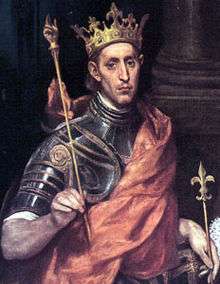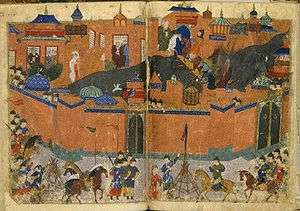An-Nasir Yusuf
| Salah ad-Din Yusuf | |
|---|---|
| Al-Malik an-Nasir | |
| Sultan of Damascus | |
| Reign | 1250 – 1260 |
| Predecessor | Al-Muazzam Turanshah |
| Successor | Sultanate abolished |
| Emir of Aleppo | |
| Reign | 26 November 1236 – 1260 |
| Predecessor | Al-Aziz Muhammad |
| Successor | Emirate abolished |
| Regent |
Dayfa Khatun (1236–1242) |
| Born | 1228 |
| Died | 1260 |
| Issue | Al-Aziz |
| Dynasty | Ayyubid |
| Father | Al-Aziz Muhammad |
| Religion | Sunni Islam |
An-Nasir Yusuf (Arabic: الناصر يوسف; AD 1228–1260), fully al-Malik al-Nasir Salah al-Din Yusuf ibn al-Aziz ibn al-Zahir ibn Salah al-Din Yusuf ibn Ayyub ibn Shazy (الملك الناصر صلاح الدين يوسف بن الظاهر بن العزيز بن صلاح الدين يوسف بن أيوب بن شاذى), was the Ayyubid Emir of Syria from his seat in Aleppo (1236–1260) and the Sultan of the Ayyubid Empire from 1250 until the sack of Aleppo by the Mongols in 1260.
Background
An-Nasir Yusuf was the great-grandson of Saladin. He became the Ayyubid ruler of Aleppo when he was 7 years old after the death of his father Al-Aziz Muhammad. His grandmother Dayfa Khatun, daughter of Al-Adil I, was his regent until her death in 1242.
Conflict with Egyptian Mamluks
When the Ayyubid sultan of Egypt as-Salih Ayyub died and his son Turanshah was murdered by the Bahri Mamluks of Egypt, Shajar al-Durr (widow of as-Salih Ayyub ) seized the throne of Egypt (1250). An-Nasir Yusuf, being an Ayyubid, refused to recognize Shajar al-Durr as the Sultana of Egypt and, as a sign of support, the Emirs of Syria granted him the city of Damascus, in Syria.
Alarmed by these developments, the Mamluk leaders in Egypt decided to replace Shajar al Durr with the Atabek (commander in chief) Aybak. In October 1250 an-Nasir Yusuf sent forces to Gaza to conquer Egypt and overthrow Aybak, but Egyptian forces led by Faris ad-Din Aktai defeated them.
In January 1251 an-Nasir Yusuf led another army to Egypt and clashed with Aybak's army in a significant battle with Yusuf's defeat. He fled back to Damascus, though some of his soldiers who could reach Cairo spread the initial impression inside Egypt that Yusuf had won the battle. Later when the news of Aybak's ultimate victory arrived, the soldiers and their commanders were arrested, and Aybak sent back the soldiers, some 3,000 in number, to Damascus on the backs of donkeys.[1]

In 1253, through mediation of some Emirs, an accord was reached between an-Nasir Yusuf and Aybak which gave the Egyptians control over Gaza, Jerusalem, Nablus, and the coastline of al-Sham. In 1254, another power shift occurred in Egypt, as Aybak killed Faris ad-Din Aktai, the leader of the Bahri Mamluks. Some of his Mamluks, among them Baibars al-Bunduqdari and Qalawun al-Alfi, fled to an-Nasir Yusuf in Syria, persuading him to break the accord and invade Egypt. Aybak wrote to an-Nassir Yusuf warning him of the danger of these Mamluks who took refuge in Syria, and agreed to grant him their territorial domains on the coast, but an-Nasir Yusuf refused to expel them and instead returned to them the domains which Aybak had granted.
In 1255 an-Nasir Yusuf sent new forces to the Egyptian border, this time with many of Aktai's Mamluks, among them Baibars al-Bunduqdari, and Qalawun al-Alfi, but he was defeated again.
Relations with Crusaders

An-Nasir had contact and correspondence with the European Crusaders, and tried to reach an accord with the barons of Acre. He indirectly suggested to King Louis IX of France the possibility of surrendering Jerusalem to Louis, in return for assistance in conquering Egypt. But Louis, who had already lost an army in Egypt during the Seventh Crusade and was still trying to free his imprisoned soldiers, was not willing yet to make such a deal. Louis did, however, send his royal armorer to Damascus to purchase materials to make crossbows, and in 1254, An-Nasir signed a truce with the Crusaders.
The Mongols

The Egyptian ruler Aybak was murdered in 1257 and his young son al-Mansur Ali, only 15 years old, became the new sultan, with Qutuz as vice-sultan. The following year (1258) the Mongols led by Hulagu Khan sacked Baghdad.
Baibars al-Bunduqdari argued that an-Nasir Yusuf should mobilize his army and make preparations to fight the Mongols who were marching towards Syria. But instead, Yusuf sent his son al-Malik al-Aziz with a present to Hulagu, requesting Hulagu's assistance in invading Egypt. Hulagu's reply, however, was simply a warning that Yusuf should rapidly submit to Mongol authority. This answer frightened an-Nasir Yusuf, who at once sent a message to Egypt, requesting help. Saif ad-Din Qutuz, the vice-Sultan of Egypt decided to confront the Mongols. Arguing that Egypt could not face the approaching danger while ruled by a young boy, Qutuz proclaimed himself Sultan, and began to raise a large army, though he assured an-Nasir Yusuf that his action was only a temporarily measure till the danger of the Mongols was overcome.
As the Mongols marched toward Aleppo, some of an-Nasir Yusuf's advisors recommended surrendering to Hulagu as the best solution. This angered Baibars and his Mamluks who attempted to assassinate an-Nasir Yusuf, but he escaped and fled with his brother to the castle of Damascus, also sending his wife, son, and money to Egypt. Many of the citizens of Damascus also fled to Egypt.
The sack of Aleppo
The Mongols arrived at Aleppo in December 1259. Turanshah, the uncle of an-Nasir Yusuf,[2] refused to surrender. After a siege of seven days, the Mongols stormed Aleppo and massacred its population for another five days. Turanshah left the city and died a few days later. When the news of the sack of Aleppo reached an-Nasir Yusuf, he and his army fled towards Gaza on January 31, stopping at Nablus for several days and leaving a contingent which may have been intended as a rearguard.[3] After the capture of Damascus, some of the Mongol troops raided Palestine, and fought with an-Nasir's troops in the olive groves of Nablus, defeating the entire force.
Damascus fell to the hands of the Mongols, under general Kitbuqa, 16 days after the sack of Aleppo. The Emirs of Damascus surrendered without resistance.[3]
Once arriving at the border with Egypt, some Emirs of an-Nasir Yusuf abandoned him and joined Qutuz. An-Nasir Yusuf, his son al-Aziz, and his brother al-Zahir were abducted in Gaza by one of his servants and were sent to Hulagu,[4] An-Nasir and his brother were executed after Hulagu heard the news of the defeat of the Mongol army at Ain Jalut by an Egyptian army led by Qutuz and Baibars on September 3, 1260.
See also
References
Citations
- ↑ al-Maqrizi
- ↑ Turanshah uncle of an-Nasir Yusuf, not to be confused with his namesake Turanshah son of sultan as-Salih Ayyub.
- 1 2 Amitai, Reuven (1987). "Mongol Raids into Palestine (AD 1260 and 1300)". Journal of the Royal Asiatic Society: 236–255.
- ↑ In another account, an-Nasir went to Kitbuga who arrested him and sent him to Hulagu.
Bibliography
- Abu al-Fida, The Concise History of Humanity
- Al-Maqrizi, Al Selouk Leme'refatt Dewall al-Melouk, Dar al-kotob, 1997.
- Idem in English: Bohn, Henry G., The Road to Knowledge of the Return of Kings, Chronicles of the Crusades, AMS Press, 1969.
- Al-Maqrizi, al-Mawaiz wa al-'i'tibar bi dhikr al-khitat wa al-'athar,Matabat aladab,Cairo 1996, ISBN 977-241-175-X.
- Idem in French: Bouriant, Urbain, Description topographique et historique de l'Egypte,Paris 1895
- The New Cambridge Medieval History (Volume 5),Cambridge University Press 1968
- O. Hassan ,Al-Zahir Baibars, Dar al-Amal 1997
- Britannica Concise Encyclopedia, information about Ayyubid dynasty
- E.J. Brill, Encyclopaedia of Islam 1954
- H. Sadawi, Almamalik, Arabic center for publications
- The New Encyclopædia Britannica,1973
- organ, David, The Mongols, 1990.
- Ibn Khaldun, history of Ibn khaldun
- Peter N. Stearns,The Encyclopedia of World History, Sixth edition, 2001
- Ibn Taghri, al-Nujum al-Zahirah Fi Milook Misr wa al-Qahirah, al-Hay'ah al-Misreyah 1968
- History of Egypt, 1382-1469 A.D. by Yusef. William Popper, translator Abu L-Mahasin ibn Taghri Birdi, University of California Press 1954
- Coptic history Encyclopedia, coptichistory.org
- Jaroslav Folda, Crusader Art in the Holy Land, From the Third Crusade to the Fall of Acre, Cambridge University Press 2005
| An-Nasir Yusuf Born: 1228 Died: 1260 | ||
| Regnal titles | ||
|---|---|---|
| Preceded by Al-Aziz Muhammad |
Emir of Aleppo 26 November 1236 – 1260 with Dayfa Khatun (1236–1242) |
Vacant |
| Preceded by Al-Muazzam Turanshah |
Sultan of Damascus 1250 – 1260 | |